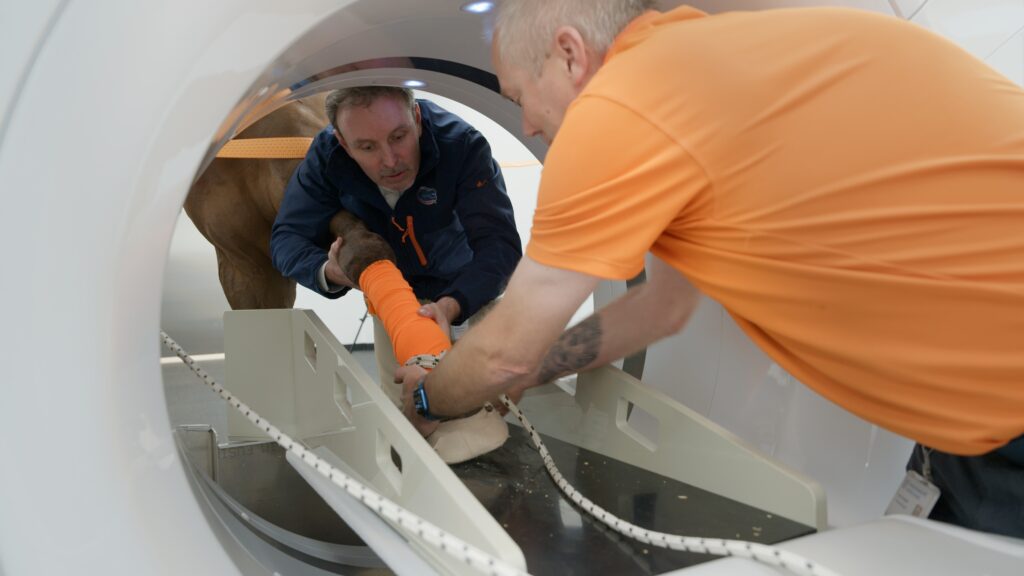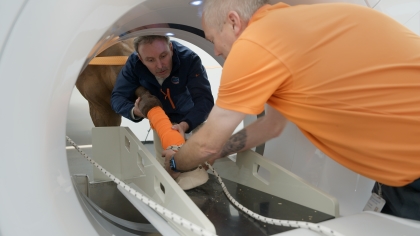
At the University of Florida Veterinary Hospital at World Equestrian Center – Ocala, our advanced diagnostic imaging technologies includes the Qalibra-Canon Exceed LB CT, Hallmarq MRI, and LONGMILE PET scanner. Each modality provides different types of information and may be combined to provide more specific and accurate diagnosis of lameness and musculoskeletal problems.
Standing computed tomography, or CT, allows us to acquire images of the horse’s head, and portions of the neck, front and hind limbs without the need for general anesthesia. Our CT unit is a state-of-the art Canon Aquillion Exceed LB 160 slice scanner with a 90 cm field of view that takes just seconds to scan your horse once it is positioned. In the standing, sedated horse, the CT scanner helps diagnose lameness originating from the foot, fetlock, carpus (knee), tarsus (hock) and proximal suspensory (front and hind limbs). It is especially useful for diagnosing problems in the head such as sinusitis and dental disease as well as injuries and conditions affecting the lower limbs.
Under general anesthesia, CT images of the pelvis, stifle, shoulder, elbow and the entire neck can also be obtained.
Standing positron emission tomography, or PET scan, is a powerful tool that uses an injectable radioactive material, known as a radiopharmaceutical, to highlight areas of pathology that might be causing lameness. The PET scanner can image from the horse’s foot to just above the knee and hock. This modality is highly sensitive for detecting areas of rapid bone turnover and may provide more information than a traditional bone scan, as it acquires images in a 3-D fashion. It has another advantage that the images can be fused with MRI, CT or radiographic (X-ray) images. The radioisotope used also has a much shorter half-life than that used in a bone scan, which means your horse has to spend less time in the hospital and exams can be completed without an overnight stay.
As with a bone scan, PET can be used as a screening tool if the nerve or joint blocks are not definitive about the exact region causing the lameness, your horse is not amenable to nerve or joint blocks, or if there are multiple areas of suspicion of problems on blocking or other diagnostic imaging.
We also offer standing low-field MRI, which allows us to image limbs of the horse below the carpus (knee) or tarsus (hock) while standing and sedated. MRI provides excellent soft tissue imaging, as well as information about bones and joints. This modality is useful for diagnosing any lameness condition that has been localized in the lower limb, especially in the foot, in situations where X-rays or ultrasound have not provided adequate answers. As with the CT, images from the MRI can be fused with PET scan images to provide complimentary information.
Additionally, our high-powered X-ray generator and Canon wireless DR plates allow us to obtain high quality images of regions that portable machines struggle to adequately penetrate, including the thorax (chest), abdomen, and denser areas of the spinal column.
All of our diagnostic images are reviewed and reported by American College of Veterinary Radiologists Equine Diagnostic Imaging board-certified specialists.
Walk-in tours of the facility are now available on Tuesdays at 4:30 p.m. All are welcome to take advantage of this opportunity to see our remarkable new 40,000 square-foot, state-of-the-art hospital. No need to make an appointment for the Tuesday tours, but we do ask that you please leave your pets at home when you visit.
Learn more about all of our services at hospitals.vetmed.ufl.edu/wec or contact us at (352) 414-3858 for information and appointments.


